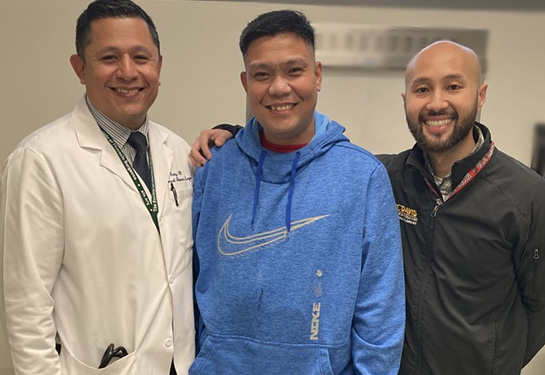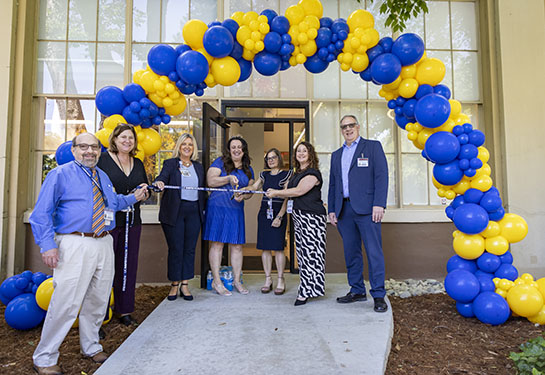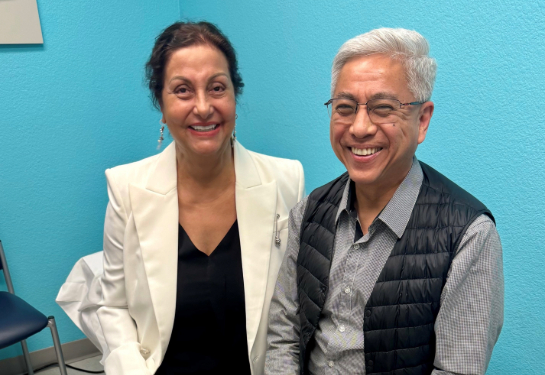Robotic-assisted procedure streamlines treatment for cancer patient
Interventional Pulmonology and Thoracic Surgery offer diagnosis and removal of cancer during single surgery
John Fernando remembers feeling like he had just been hit by a ton of bricks. The military veteran was in a patient room at the Sacramento VA Medical Center a few weeks before Christmas. He had just been told that doctors found two suspicious nodules on his lung during his surveillance appointment.
“I felt overwhelmed,” Fernando remembered. “I knew first-hand how taxing and exhausting the treatment would be. Just thinking about the possibility of having cancer again was stressful.”
Four years earlier, Fernando had undergone treatment for stage three metastatic rectal adenocarcinoma, a type of colorectal cancer at Walter Reed National Military Medical Center. At the time he was stationed in Maryland, serving as an information technology specialist for the Army.
According to the American Cancer Society, 1% to 3% of survivors develop a second cancer different from the one originally treated. Research shows that cancer survivors have an increased chance of developing cancer compared to people of the same age and gender who have not had cancer.
“My first experience having cancer was long and stressful,” Fernando explained. “There was a lot of waiting for tests and appointments — which was exhausting. Then once I had my procedure, the recovery process was very difficult.”
Minimally invasive, robotic-assisted technology
Fernando was referred to UC Davis Health. His care team included Luis Godoy, assistant professor of thoracic surgery, and Chinh Phan, director of the UC Davis Interventional Pulmonology Program.
“John’s suspicious lung nodules were very small and would have been difficult if not impossible to see with the naked eye,” Godoy explained.
Godoy and Phan determined that Fernando was a good candidate for a robotic-assisted bronchoscopy procedure. It would allow Fernando to be put under anesthesia only once while the nodules were located and biopsied — and removed if necessary.
The Interventional Pulmonology Program and Division of General Thoracic Surgery performed the first single-anesthesia diagnosis to treatment of lung cancer using a fully robotic approach in April 2022.
The procedure utilizes the Ion Endoluminal Platform by Intuitive. The high-tech system creates a 3D map of the patient’s lungs using a CT scan. The software then generates the safest and most efficient route through the lung to the nodule or mass. Once the route is determined, an ultrathin and ultra-maneuverable catheter reaches the lung nodule or mass, where it is biopsied.
The samples are then evaluated onsite. If the nodule is determined to be an early-stage cancer, the surgical team uses the same navigational route to mark the area with dye and prepare for its removal. Then, the patient, still asleep, has a second robotic procedure to remove the cancer on the same day.
“Thanks to our Ion robotic bronchoscopy platform to place a fiducial coil dyed with indocyanine green (ICG) to assist with intraoperative localization of the suspicious nodules in the periphery of John’s lung,” explained Phan. “This innovative technique can help surgeons efficiently and accurately localize difficult to find lung nodules for lung-sparing surgery.”
Upon evaluation, it was determined that Fernando’s nodules were malignant and were immediately removed using the da Vinci robotic system during the single anesthetic event.
“Because of our Ion and da Vinci minimally invasive robotic platforms, John was able to be discharged within 24 hours after his treatment,” Phan said. “It is truly a miracle that we were able to help this young patient who served our country return home cancer-free just in time to spend the holiday season with his family.”
Streamlining patient care
Just over a month following his procedure, Fernando has returned to work and his everyday life.
“After having surgery, you expect to be in bed for weeks recovering,” said Fernando. “But after a week I stopped taking my pain medication and was already starting to feel better. It was a completely different experience from the first time I was treated for cancer.”
Fernando is grateful to everyone at UC Davis Health – from Godoy, to Phan, to each nurse, technician and team member he encountered.
“Everyone I worked with was incredibly efficient and communicated all the details for my procedure,” he recalled. “They really alleviated a lot of stress and hassle for me throughout the entire process.”




